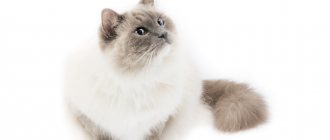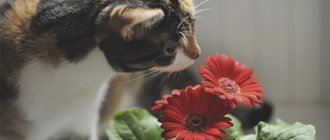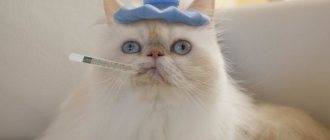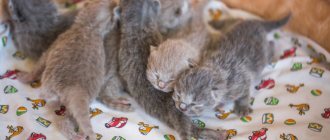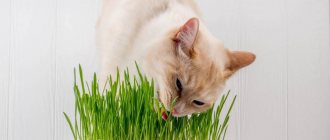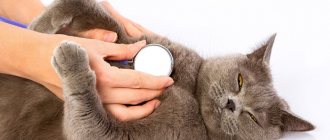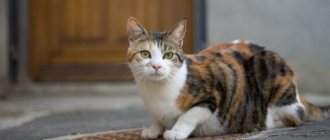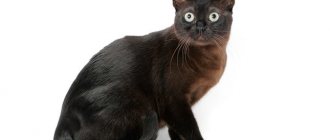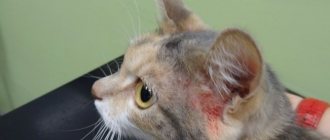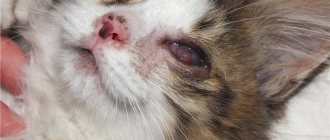Many cats are partial to indoor plants. Moreover, they often like to taste something that has an attractive smell to them. Sometimes owners don’t even think that plants growing on windowsills can become a real threat to the health and life of their pets.
Let's look at how plants are dangerous and which ones are completely poisonous for cats; Are flowers in bouquets dangerous? what are the symptoms of a cat leaving and how to provide first aid.
Plants that can harm your cat
In nature, cats often eat grass in order to clear hair from their stomachs. A lack of some vitamins or minerals in the body can also cause the animal to show interest in indoor plants. This is why cats so often attack flower pots.
But not all owners think about the fact that indoor plants can cause real harm to their pets. Some plants can lead to dermatitis, inflammation of the mouth and larynx. They are dangerous to the cat's health, but rarely does eating them lead to the death of the pet.
Other plants are very poisonous. They lead to serious poisoning, which seriously undermines the cat's health.
Dangerous plants
Either some individual parts of the plant (pollen, flower, roots or leaves) or the entire plant can be dangerous. Moreover, it is not necessary for the cat to taste the plant.
The following can also lead to negative consequences:
- pollen, which can enter the respiratory tract;
- skin contact with a dangerous plant or its juice getting into your eyes;
- drinking water that accumulates under a flower pot.
Popular houseplants that are dangerous for cats:
- Plants of the euphorbia species (euphorbia, ficus, poinsettia). These plants are also dangerous for humans. They contain juice, which upon contact with the skin causes severe inflammation and burns. These plants can cause a severe allergic reaction.
- Philodendron. Leads to inflammation of the tongue and larynx. It becomes more difficult for the animal to breathe and swallow. Possible vomiting. Over time, kidney function becomes impaired.
- Hyacinth. May lead to allergies and loss of coordination.
- Monstera. Leads to burning of the tongue and larynx. Burns and blisters may appear on the mucous membranes of the oral cavity.
- Chrysanthemum. Leads to inflammation of the oral cavity and larynx, and the appearance of dermatitis.
- Hogweed. Leads to inflammation of the oral cavity and the appearance of dermatitis.
- Dieffenbachia. Contains acid that burns the mucous membranes of the mouth and larynx. Inflammation of the tongue, lips and mouth occurs. The animal loses its appetite and it becomes more difficult for it to breathe. Plant juice that gets into the eyes can cause inflammation and even blindness.
- Sansevieria. Leads to allergic dermatitis.
- Spathiphyllum . Causes a burning sensation in the mouth and larynx, inflammation of the mucous membrane of the gastrointestinal tract.
- Caladium. Causes inflammation of the tongue and larynx. In some cases, it can lead to complete blockage of the respiratory tract, which can lead to the death of the animal.
- Kalanchoe. Causes vomiting and diarrhea.
- Begonia. Contains oxalic acid, which leads to burns of the mucous membranes of the oral cavity and swelling of the larynx.
- Epipremnum aureus. Profuse salivation begins, the cat experiences severe abdominal pain, and swelling of the mucous membrane of the oral cavity and larynx occurs.
- Scheffler. Allergic dermatitis appears on the skin.
- Oriental thuja (biota). Leads to swelling of the larynx, loss of coordination, and acute heart failure.
- Fragrant rue. Causes the appearance of dermatitis.
We recommend the article: How to rid a cat of growths on his pads?
Poisonous plants
Many of the plants on this list contain components that are poisonous to cats. Their entry into the body may well lead to the death of the animal. The most common houseplants that are poisonous to cats are:
- Azalea. A plant with red or purple flowers. Contains acid that causes severe poisoning. Dangerous, including for humans. The functioning of the central nervous system is disrupted, severe vomiting begins, and swelling of the larynx appears.
- Aloe vera. The sap of the plant is poisonous to cats. Its entry into the body leads to loss of appetite, vomiting, decreased activity, change in urine color, and convulsions.
- Amaryllis. A very toxic plant. However, it often attracts cats with its smell. Leads to severe vomiting, loss of coordination, increased salivation, and convulsions.
- English ivy. It is a climbing plant that stands out for its five-pointed leaves and small black berries. Causes a burning sensation in the tongue and throat. Inflammation of the gastrointestinal tract occurs. Severe vomiting and diarrhea begin.
- Asparagus. The toxin is found in the stems and berries of the plant. Leads to the appearance of dermatitis, vomiting, diarrhea, and severe abdominal pain.
- Anthurium. Inflammation and swelling of the oral cavity and larynx occur, and breathing is impaired.
- Buxus. Leads to serious intoxication, which often causes the death of the animal.
- Devil's ivy. Large heart-shaped leaves are covered with yellow stripes. When a cat bites a leaf, it feels a burning sensation and pain. The throat becomes inflamed. In case of severe poisoning, diarrhea and vomiting may occur.
- Dracaena . Leads to severe irritation of the mucous membranes of the digestive system. Severe vomiting begins (possibly with blood), the pupils dilate, and salivation increases. The animal may die from respiratory arrest.
- Geranium. Leads to severe stomach upset.
- Hydrangea. Contains cyanide ions. Flowers and leaves are poisonous. If ingested by a cat, it can cause severe abdominal pain, vomiting and diarrhea. The animal is shaking very much. The lungs, kidneys and heart begin to fail.
- Kutrov family (pachypodium, oleander). May cause cardiac arrest.
- Peperomia. Leads to severe heart failure, severe vomiting and loss of coordination.
- Cyclamen. A plant with beautiful bright flowers. The most dangerous are the roots. Eating them can lead to disruption of the gastrointestinal tract and profuse vomiting. In some cases, cats die.
The following plants may grow in the garden and are also poisonous to cats:
- Poppy.
- Daisies.
- Pansies.
- Tobacco.
- Oleander.
- Dogwood.
- Oregano.
Plants in bouquets
Not only that, indoor plants growing in pots can become a source of danger for cats. Some cut flowers, with bouquets of which people often decorate their homes, can also lead to very sad consequences for the pet.
Plants in bouquets that are dangerous for cats:
- Tulip. May lead to allergic dermatitis or severe poisoning. There is a disruption of the central nervous system and gastrointestinal tract.
- Narcissus. If ingested by a cat, it can result in profuse vomiting and severe diarrhea. In the absence of timely assistance, the animal may die from heart or pulmonary failure.
- Lilies. Pollen is considered the most dangerous. Its entry into the body leads to swelling of the larynx, heart failure, and disruption of the central nervous system.
- Lily of the valley. Causes severe vomiting and diarrhea.
- Snowdrop. Leads to allergies, food poisoning, and cardiac arrest. Not only the plant itself is dangerous, but also the water in which it stood.
- Calla lilies. Lead to inflammation and swelling of the larynx, breathing problems, loss of coordination, and acute heart failure.
- Iris . Leaves and roots are dangerous. Leads to vomiting and diarrhea.
- Gypsophila. These are small flowers that are often used as decoration in a bouquet. If ingested by a cat, they lead to severe vomiting and diarrhea.
We recommend the article: Tumor of the lower jaw in a cat: causes and treatment
It is worth noting that not only the bouquet itself, but also the water in the vase from under it can be dangerous for the cat. Often flowers are placed in a special solution. This is necessary so that the bouquet retains its fresh appearance for as long as possible. Some components of the solution remain on the stems after purchase. Afterwards they end up in a vase and in water, which the animal can drink. Aspirin, which is often added to a vase to prevent flowers from wilting so quickly, is also dangerous for cats.
Plants on balconies are dangerous because they can attract bees. If a cat likes to hunt, it can easily get bitten. In some cases, this can lead to very serious health problems.
Ficus
Ficus is an ornamental plant that decorates many homes. It has gained recognition due to the lack of difficulties in growing and its appearance, which can diversify even the simplest interiors. The houseplant, also known as ficus, comes in many varieties.
Any variety of this plant will irritate both your skin and the mucous membranes of your pet's digestive tract.
- Easy to grow, ficus comes in many varieties, all of which are dangerous for cats. It can irritate your pet's skin and digestive tract.
All varieties of ficus are poisonous to cats.
Possible consequences
Contact with plants that are dangerous to cats can lead to various consequences. The negative influence of some colors can accumulate, causing the animal's health to deteriorate over time. Other plants can lead to serious poisoning and a sharp deterioration in the animal’s condition.
Symptoms of allergies caused by plants:
- tearfulness;
- nasal discharge;
- frequent sneezing;
- the appearance of inflammation on the skin;
- the animal constantly scratches one place (muzzle, withers or another).
If harmful components enter the body, the following symptoms may occur:
- increased salivation;
- diarrhea;
- nausea;
- decreased appetite;
- decline in activity.
In case of poisoning, the following symptoms are observed:
- frequent and severe vomiting (sometimes mixed with blood);
- diarrhea;
- significant increase in body temperature;
- complete loss of appetite;
- a sharp decline in activity, apathy.
In case of severe poisoning, the animal’s condition deteriorates sharply and quickly. Intoxication leads to disruption of internal organs, which can result in the death of the animal. This is why in case of poisoning you should immediately consult a doctor. Sometimes the hours count!
What to do if your cat stubbornly chews unsafe greens
Your furry pet needs to be weaned off the habit of chewing plants. The owners will need a little patience and time. The most important thing is to choose a balanced diet. Your cat should always have clean water and nutritious food rich in vitamins. Be sure to give your pet his favorite grass: sprouted oats, catnip, wheatgrass. You can buy them at a pet store.
Important! All flower pots must be removed where the cat cannot reach them. You can hang them on the walls in flowerpots, place them on a balcony, mezzanine or top shelves.
When the cat goes to the flower and chews it, you need to spray it with water from a spray bottle. Pet stores sell special repellers. The pet will quickly understand that chewing flowers is punishable.
If a cat chews a poisonous flower, there is no other option but a spray bottle
The best way to ensure that both the wolves are fed and the sheep are safe is to maintain order and cleanliness in the house. To save the flower and not harm the cat, you need to hide dangerous flowers away. You can offer your cat green sprouts of young oats for chewing.
First aid
If any symptoms of illness appear in your pet, it must be immediately shown to a doctor. Only a veterinarian can make an accurate diagnosis and take all necessary measures.
If the animal exhibits all the symptoms of poisoning, first aid should be provided at home:
- It is necessary to give the cat a sorbent that will reduce the impact of toxins on the body (activated carbon, polysorb, adsorbent).
- You need to assemble a carrier. A diaper should be placed at the bottom in case the animal vomits or has diarrhea. You should take a towel and blanket with you in case your cat gets chills.
- If the animal does not have the strength to move and the vomiting does not stop, the cat should be placed on its side so that it does not suffocate from the vomit.
- You need to immediately see which plant caused the poisoning. This information will be useful to your veterinarian.
- It may be necessary to perform a gastric lavage with saline solution. But this option should only be used if it is not possible to urgently take the animal to a doctor. It is better if the veterinarian monitors the procedure at least by telephone.
Bromeliad - is it poisonous?
A plant from the pineapple family is called guzmanania. Its leaves can have different shades - green, burgundy, brown. The flowers, however, take on a bright, red or orange color. Bromeliads are different in that they dry out after releasing the flower, which is a natural process.
Bromeliads are described as non-toxic to cats, so you can decorate your home with them if you have a pet. Do you want her to look beautiful for as long as possible? Place it out of the cat's reach and take additional care to keep the soil moist and regularly misting the leaves, but not the flowers. Guzmania requires a warm location and sunlight, but do not expose it to direct contact with intense sunlight as this may damage the delicate flower.
- Bromeliads are considered safe for cats. A plant from the pineapple family needs a moist substrate, frequent spraying and a warm place.
Non-hazardous plants
There are plants that have a very unpleasant smell for cats. You can put them on the windowsill without fear, because your pet won’t even come near it.
We recommend the article: Coronavirus in cats. Symptoms Dangerous consequences.
Plants that your cat definitely won’t touch:
- lemongrass;
- mandarin;
- sheddock;
- kinkan;
- calamondin;
- panderosa;
- coleus canine (has an unpleasant odor not only for cats, but also for other animals).
Houseplants that are generally safe for cats:
- violet;
- chlorophytum;
- jasmine;
- camellia;
- begonia;
- dracaena;
- peperomia;
- arrowroot;
- indoor grapes;
- coleus;
- Venus flytrap.
It should be noted that these plants are safe for most cats. However, there remains a possibility that these plants may cause an allergic reaction in some animals.
Cat grass (sprouted oats) can be called not only a safe, but even a useful plant. Its seeds are sold in pet stores. It sprouts within a few days and does not require special care. Such grass will delight the owner with its beautiful greenery, but the cat will be able to chew it to its heart’s content, get all the necessary components and cleanse its stomach.
Vomiting after eating cat grass is not a sign of poisoning.
The following plants are also beneficial for cats:
- mint;
- thyme;
- cat mint;
- valerian;
- thyme;
- Melissa.
But it is worth remembering that the cat should not consume too much of these plants, otherwise an overdose or an allergic reaction is possible. Valerian and catnip are especially dangerous, as some cats react too zealously to their smell. These herbs can be dried and filled into cat toys.
Safe window sill landscaping
Poisonous indoor plants and flowers for cats should not be in close proximity to the animal. Flora connoisseurs who don’t want their windows to be empty replace toxic plants with safe ones:
- ficus;
- arrowroot;
- chlorophytum;
- sago palm;
- indoor rose;
- violet;
- Coleus
There are fewer harmless plants than prohibited ones, but there is plenty to choose from. The correct selection of indoor flowers will not only decorate the interior, but will also provide the cat with a useful garden. Pamper your pet with catnip, thyme, wheat, thyme, camellia, peperomia, argent or indoor grapes. Toys made from dried flowers will delight your cat, and the animal’s gratitude will know no bounds.
Option 5
You can come up with decorative interior solutions . For example, on the inside of the windows, build a partition for pots with plants around the entire perimeter, which you can open and close.
It is not advisable to make hanging structures and shelves on the window itself, since cats love to climb into hard-to-reach places and show talent for climbing on absolutely flat surfaces. Such a decision may be perceived as a call to action.
But hanging pots are a good solution. The main thing is that they cannot be reached while jumping.
Hanging pots save you from cats
Cats don't like things rustling under their paws or fur sticking to them. Perhaps laying out foil or double-sided tape around the plant will help you. When using foil or tape, you must always remember that the animal can eat these items, which can end very badly.

